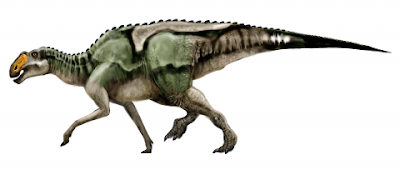Gryposaurus monumentensis
Abstract
new species of the hadrosaurine hadrosaurid Gryposaurus was discovered in the late Campanian Kaiparowits Formation of southern Utah. Gryposaurus monumentensis, sp. nov. is distinguished from other Gryposaurus species by possessing a more robust skull, enlarged clover-shaped prongs on the predentary oral margin, an anteroposteriorly narrow infratemporal fenestra, and other autapomorphies plausibly associated with feeding adaptations. The derived morphology revealed in G. monumentensis necessitates revision of the generic diagnosis of Gryposaurus, including the addition of synapomorphies that further aid in distinguishing this taxon from Kritosaurus. A revised phylogenetic analysis places Gryposaurus within a monophyletic clade that includes Brachylophosaurus and Maiasaura. Gryposaurus monumentensis represents the most southern example of Gryposaurus, and underlines the remarkable diversification and long duration of this genus. Based on the phylogenetic, geographical, and stratigraphic evidence at hand, Gryposaurus was the most diverse genus within Hadrosaurinae; it also possessed one of the largest geographical and stratigraphic distributions, spanning more than five million years of the Campanian, and ranging from Alberta in the north to Utah (and possibly Texas) in the south.
Keywords: biogeography; Cretaceous; dinosaur; hadrosaur; hadrosaurinae; ornithopod
Gryposaurus monumentensis
(Pronunciation: GRIP-oh-SORE-us MAHN-you-men-TEN-siss)
Age: Late Cretaceous (~76 million years ago)
Locality: Kane and Garfield counties, Grand Staircase-Escalante National Monument, Utah.
Geologic Formation: Kaiparowits Formation (middle unit)
Classification: Ornithischia – Ornithopoda – Hadrosauridae - Hadrosaurinae
Description: Hadrosaurids are often referred to as “duck-billed” dinosaurs because the front of their skull resembles a bill of a duck. Even the name Gryposaurus means “hooked beak lizard.” “Monumentensis” gives credit to Grand Staircase-Escalante National Monument in southern Utah where these animals were found. There are two types of hadrosaurs: those without crests, such as Gryposaurus monumentensis, and those with crests on top of their heads, called lambeosaurines. Gryposaurus monumentensis is unique compared with other species of Gryposaurus in that it the front part of the “beak” rises at a steeper angle. Three to four species of Gryposaurus have been found with a range from as far north as Alberta, Canada, to as far south as Texas, making Gryposaurus the genera with one of the largest geographical ranges. Gryposaurus was a very large duck-billed dinosaur – easily reaching the same size as Tyrannosaurus rex.
Gryposaurus monumentensis
A) Gryposaurus monumentensis B) Gryposaurus notabilis
C) Gryposaurus incurvimanus D) Gryposaurus latidens
Gates, T. A., and S. D. Sampson. 2007. A new species of Gryposaurus (Dinosauria: Hadrosauridae) from the late Campanian Kaiparowits Formation, southern Utah, USA. Zoological Journal of the Linnean Society. 151:351-376. http://dx.doi.org/10.1111/j.1096-3642.2007.00349.x
Huge duck-billed dinosaur unearthed in Utah | COSMOS magazine: http://bit.ly/N35Fgr




